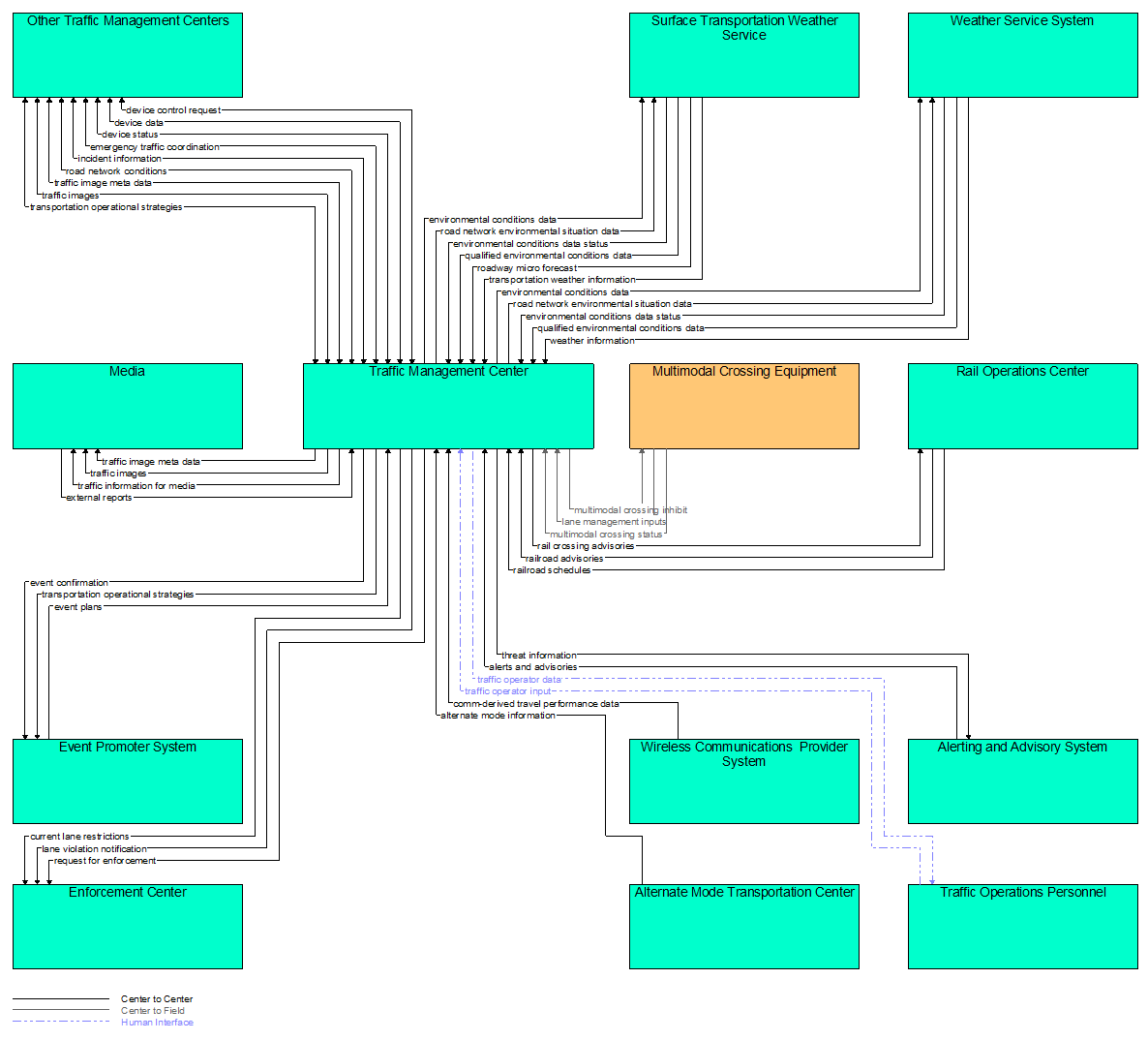Kind: Subsystem
Class: Center
Type: System
Traffic Management Center
Overview
The 'Traffic Management Center' monitors and controls traffic and the road network. It represents centers that manage a broad range of transportation facilities including freeway systems, rural and suburban highway systems, and urban and suburban traffic control systems. It communicates with ITS Roadway Equipment and Connected Vehicle Roadside Equipment (RSE) to monitor and manage traffic flow and monitor the condition of the roadway, surrounding environmental conditions, and field equipment status. It manages traffic and transportation resources to support allied agencies in responding to, and recovering from, incidents ranging from minor traffic incidents through major disasters.
This physical object is included in the following Service Packages:
- CVO04: CV Administrative Processes
- CVO05: Commercial Vehicle Parking
- CVO06: Freight Signal Priority
- CVO09: Freight-Specific Dynamic Travel Planning
- CVO10: Road Weather Information for Freight Carriers
- DM01: ITS Data Warehouse
- MC04: Winter Maintenance
- MC06: Work Zone Management
- MC08: Maintenance and Construction Activity Coordination
- MC11: Maintenance and Construction Signal Priority
- MC12: One-Way Convoy Driving
- PM01: Parking Space Management
- PM04: Regional Parking Management
- PS01: Emergency Call-Taking and Dispatch
- PS03: Emergency Vehicle Preemption
- PS06: Incident Scene Pre-Arrival Staging Guidance for Emergency Responders
- PS07: Incident Scene Safety Monitoring
- PS08: Roadway Service Patrols
- PS09: Transportation Infrastructure Protection
- PS10: Wide-Area Alert
- PS11: Early Warning System
- PS12: Disaster Response and Recovery
- PS13: Evacuation and Reentry Management
- PS14: Disaster Traveler Information
- PT01: Transit Vehicle Tracking
- PT02: Transit Fixed-Route Operations
- PT03: Dynamic Transit Operations
- PT09: Transit Signal Priority
- PT10: Intermittent Bus Lanes
- PT14: Multi-modal Coordination
- PT17: Transit Connection Protection
- ST01: Emissions Monitoring
- ST02: Eco-Traffic Signal Timing
- ST03: Eco-Traffic Metering
- ST04: Roadside Lighting
- ST06: HOV/HOT Lane Management
- ST07: Eco-Lanes Management
- ST08: Eco-Approach and Departure at Signalized Intersections
- ST10: Low Emissions Zone Management
- TI01: Broadcast Traveler Information
- TI02: Personalized Traveler Information
- TI03: En-Route Guidance
- TI04: Trip Planning and Payment
- TI07: In-Vehicle Signage
- TM01: Infrastructure-Based Traffic Surveillance
- TM02: Vehicle-Based Traffic Surveillance
- TM03: Traffic Signal Control
- TM04: Connected Vehicle Traffic Signal System
- TM05: Traffic Metering
- TM06: Traffic Information Dissemination
- TM07: Regional Traffic Management
- TM08: Traffic Incident Management System
- TM09: Integrated Decision Support and Demand Management
- TM10: Electronic Toll Collection
- TM12: Dynamic Roadway Warning
- TM13: Standard Railroad Grade Crossing
- TM14: Advanced Railroad Grade Crossing
- TM15: Railroad Operations Coordination
- TM16: Reversible Lane Management
- TM17: Speed Warning and Enforcement
- TM18: Drawbridge Management
- TM19: Roadway Closure Management
- TM20: Variable Speed Limits
- TM21: Speed Harmonization
- TM22: Dynamic Lane Management and Shoulder Use
- TM23: Border Management Systems
- TM24: Tunnel Management
- TM25: Wrong Way Vehicle Detection and Warning
- TM26: Signal Enforcement
- VS05: Curve Speed Warning
- VS06: Stop Sign Gap Assist
- VS07: Road Weather Motorist Alert and Warning
- VS08: Queue Warning
- VS09: Reduced Speed Zone Warning / Lane Closure
- VS10: Restricted Lane Warnings
- VS11: Oversize Vehicle Warning
- VS12: Vulnerable Road User Safety
- VS13: Intersection Safety Warning and Collision Avoidance
- VS15: Infrastructure Enhanced Cooperative Adaptive Cruise Control
- VS17: Automated Vehicle Operations
- WX01: Weather Data Collection
- WX02: Weather Information Processing and Distribution
- WX03: Spot Weather Impact Warning
- WX04: Roadway Micro-Prediction
Functionality
Triples
Security
This physical object has the following security levels for the associated service packages.
This interfaces diagram had many interfaces and so was broken up into a Subsystem and Terminator interfaces diagram.
Subsystem Interfaces Diagram

Standards
The following table lists the standards associated with the physical object itself (as opposed to standards associated with an interface). For standards related to interfaces, see the specific information flow triple pages.
| Name | Title |
|---|---|
| NEMA TS 8 Cyber and Physical Security | Cyber and Physical Security for Intelligent Transportation Systems |
